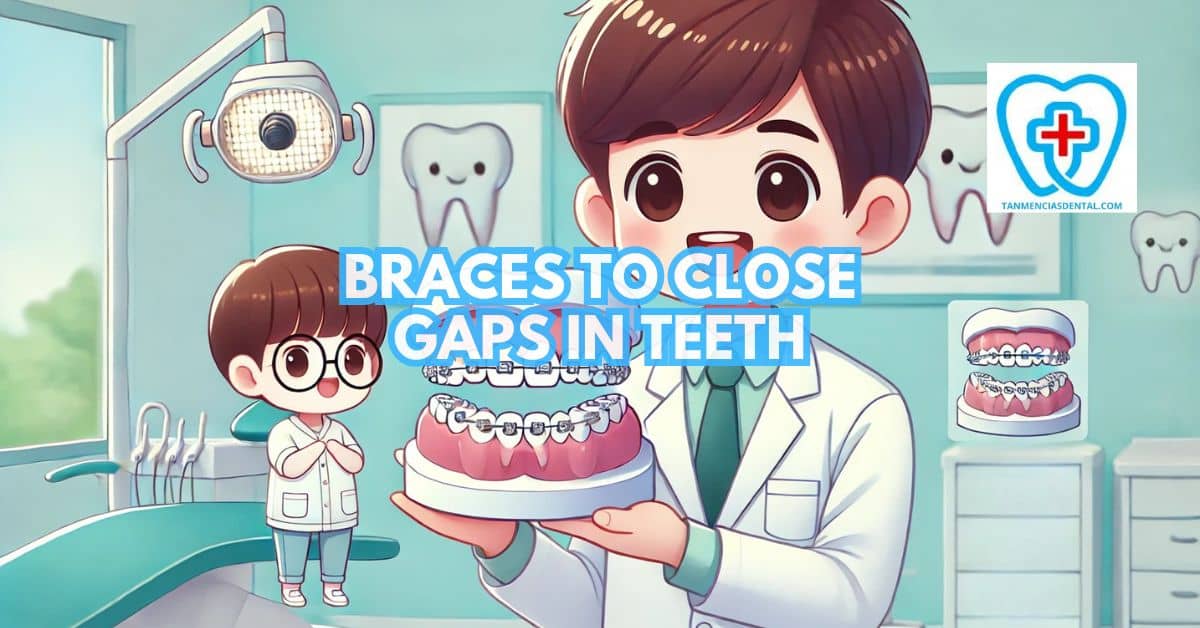Gaps in teeth, also called diastemas, are spaces that form between two or more teeth.
These gaps can occur naturally or develop due to certain habits and dental conditions.
While some individuals may view gaps as a unique feature, others might be concerned about their health implications.
Addressing gaps is not just about appearance; it can also involve improving oral functionality.
We’ll explain how braces can help close gaps and whether orthodontic treatment might be right for you.
1. What Are Gaps in Teeth and Why Do They Happen?
Gaps can develop for several reasons, including the size difference between the jaw and teeth.
If your teeth are smaller compared to your jaw, they may spread out, creating spaces.
Habits like thumb-sucking during childhood or tongue thrusting can push teeth apart.
In some cases, gum disease weakens the supporting tissue and causes teeth to move.
Identifying the reason for your gaps helps professionals recommend the most effective treatment.
🦷 How to Whiten Your Teeth After Braces and Flash a Brighter Smile
2. When Gaps Affect Your Ability to Chew and Speak Properly
Large gaps can make it difficult to chew food evenly, leading to discomfort and poor digestion.
Spaces between teeth may also cause a lisp or difficulty pronouncing certain words clearly.
Over time, this can lower your confidence when speaking in public.
Braces align teeth properly, which enhances both chewing and speech functions.
Early intervention can prevent these challenges from becoming long-term issues.
🦷 Should You Brush Your Teeth Before or After Whitening Strips?
3. The Aesthetic Benefits of Closing Gaps in Teeth with Braces
Many people feel self-conscious about gaps in their teeth, especially when they are noticeable in photographs or conversations.
Closing these gaps can give your smile a more balanced and harmonious appearance.
This often boosts self-esteem and encourages a willingness to smile more freely.
Braces are designed to gradually shift teeth, closing gaps without harming other teeth.
The end result is a natural-looking, even smile that enhances your overall look.
🦷 Understanding the Collaboration Between Dentist and Dental Hygienists in Oral Care
4. How Gaps in Teeth Can Indicate Misalignment or Bite Problems
Spaces between teeth often signal underlying alignment issues, such as an overbite or underbite.
Misalignment can create uneven pressure on your teeth during biting or chewing, which may lead to cracks, chips, or excessive wear.
As time passes, these issues can worsen, increasing the risk of jaw pain or damage to teeth.
Braces not only close gaps but also correct the position of teeth to ensure a proper bite.
Addressing these problems early can prevent more serious dental complications.
🦷 Is Bonding a Chipped Tooth the Right Solution for Your Dental Needs?
5. Jaw Pain and Discomfort: A Sign That Braces Might Be Needed
Frequent jaw pain may be linked to gaps and misaligned teeth.
When teeth are not aligned, the jaw muscles have to work harder to chew and support your bite.
This added strain can cause soreness, headaches, or even clicking and popping sounds in the jaw.
Braces help distribute pressure evenly across all teeth by correcting alignment.
Reducing strain on the jaw can lead to greater comfort in daily life.
🦷 Can You Brush Your Teeth Without Toothpaste?
6. The Importance of Proper Oral Hygiene When You Have Gaps in Your Teeth
Gaps create small spaces where food particles and plaque can collect, making it harder to clean your teeth properly.
These areas can become breeding grounds for bacteria, increasing the risk of cavities and gum disease.
Even with careful brushing and flossing, gaps may still be difficult to clean effectively.
Closing the gaps with braces simplifies oral hygiene and helps prevent future dental problems.
This promotes healthier teeth and gums over the long term.
🦷 The Benefits of Bonding Chipped Front Teeth: A Quick and Affordable Smile Makeover
7. Why Gaps in Teeth May Worsen Over Time
Teeth naturally shift over time, especially when gaps are already present.
These shifts can widen the spaces, making the gaps more noticeable and leading to further alignment issues.
As gaps grow, they can cause neighboring teeth to tilt or move, complicating the alignment even more.
Addressing gaps early with braces can stop these changes and preserve a stable, even smile.
Early treatment is usually less complex and more effective than addressing advanced issues later.
🦷 Fun and Creative Ways for Teaching Children Oral Hygiene Habits
8. How Gaps in Teeth Can Impact Your Confidence and Self-Esteem
Having visible gaps in your teeth can make you feel self-conscious about your smile.
This may affect how you interact with others, particularly in situations where first impressions are important.
Some people avoid smiling or speaking up due to embarrassment about their teeth.
Braces provide a way to close these gaps and rebuild your confidence.
Feeling good about your smile can positively influence your personal, social, and professional life.
🦷 Choosing the Best Braces Colors to Make Teeth Look Whiter
9. Why You Should Consult an Orthodontist About Closing Gaps in Your Teeth
Orthodontists are experts in diagnosing and treating issues related to gaps and alignment.
They use tools like X-rays and digital scans to assess your teeth and jaw structure.
Based on these evaluations, they create a customized treatment plan tailored to your needs.
Consulting an orthodontist ensures you get the most effective and safe care for closing gaps.
It is an important step toward achieving a healthier, more functional smile.
🦷 How to Stop Your Teeth From Hurting With Braces
10. Are There Alternatives to Braces for Closing Gaps in Teeth?
Alternatives to braces include clear aligners, dental bonding, and veneers, depending on the size and location of the gaps.
Clear aligners are less noticeable and a popular option for adults who prefer a discreet solution.
Bonding and veneers can quickly close small gaps but may not be suitable for larger or more complex issues.
These options often do not address underlying alignment problems like braces do.
Discussing your choices with an orthodontist will help you find the best option for your situation.
👨⚕️ Conclusion
If gaps in your teeth are causing functional problems or affecting your confidence, braces could be the solution you need.
Braces not only close gaps but also resolve alignment and bite issues, improving your oral health overall.
Addressing these concerns early can save time, money, and discomfort in the future.
Consulting an orthodontist will provide clarity on the most effective treatment plan for your needs.
Closing gaps with braces is often the key to a healthier, more confident you.
😊 Self-Promotion
Looking for a trusted dental clinic in Parang, Marikina City?
Visit Tan-Mencias Dental Clinic, where your smile is our top priority!
Whether you have questions or need to book an appointment, you can reach us by calling 09171451074, sending a message through our Facebook page, or using the contact form on our website.
Our friendly team is always ready to assist you with all your dental care needs.
Come and experience the personalized care you deserve—we can’t wait to see your smile!

